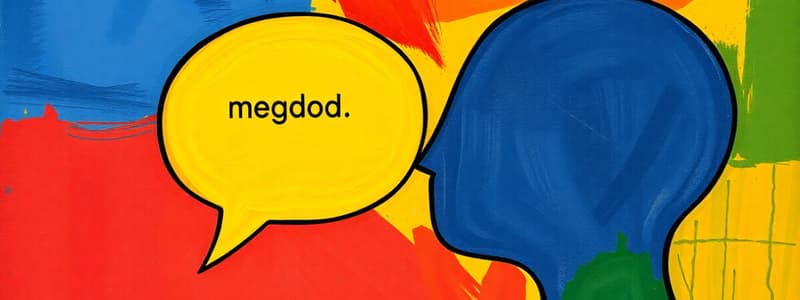Podcast
Questions and Answers
Qual es le tipo de verbal communication?
Qual es le tipo de verbal communication?
- Immagines e videos
- Emails e blogs
- Face-to-face conversations (correct)
- Scrittura de cartas
Qual es le exemplo de communication intimate?
Qual es le exemplo de communication intimate?
- Laws e regulamentos
- Speeches
- Conversation inter parejas (correct)
- Discussiones in grupo
In le zero conditional, qual es le forma corecte de construction?
In le zero conditional, qual es le forma corecte de construction?
- Would + base form
- Should + base form
- Present simple + present simple (correct)
- Had + past participle
Qual de le sequente es un exemplo de communication visual?
Qual de le sequente es un exemplo de communication visual?
Qual verbo modal indica obligation?
Qual verbo modal indica obligation?
Qual de le sequente solo se usa in contextos formales?
Qual de le sequente solo se usa in contextos formales?
Qual de le sequente es un exemplo de communication non-verbal?
Qual de le sequente es un exemplo de communication non-verbal?
Qual de le sequente describi le secunde conditional?
Qual de le sequente describi le secunde conditional?
In qual contextu es le communication consultative tipicamente usate?
In qual contextu es le communication consultative tipicamente usate?
Qual de le sequente modales indica prohibition?
Qual de le sequente modales indica prohibition?
Flashcards are hidden until you start studying
Study Notes
Modals
- Modals indicate necessity, possibility, permission, and obligations.
Types of Modal Verbs
Permission
- Utilized to ask for or grant consent.
Obligation
- Indicates a requirement or necessity to do something.
Prohibition
- Expresses something that is not allowed.
Possibility
- Shows the likelihood of something happening or being true.
Conditional Statements
Zero Conditional
- Used for general truths or laws, often in the structure: If + present simple, + present simple.
First Conditional
- Describes a real possibility in the future: If + present simple, + will + base verb.
Second Conditional
- Discusses hypothetical situations: If + past simple, + would + base verb.
Third Conditional
- Reflects on past situations that did not happen: If + past perfect, + would have + past participle.
Communicative Styles
Communication
- Various modes contribute to how individuals convey messages.
Martin Joos
- Identified different communicative styles based on context and formality.
Frozen Style
- Used in formal contexts like poems, laws, and vows, featuring fixed language.
Formal Style
- Present in speeches, laws, and official addresses requiring a structured format.
Consultative Style
- Occurs in group discussions and professional settings, characterized by a two-way exchange.
Casual Style
- Involves informal interactions like chats, letters to friends, and social media.
Intimate Style
- Personal conversations between close friends or family members, often involving private topics.
Types of Communication
Verbal Communication
- Encompasses speaking through face-to-face conversations, video calls, or lectures.
Non-Verbal Communication
- Involves gestures, body language, and facial expressions in conveying messages.
Written Communication
- Includes letters, emails, reports, and any written form of information exchange.
Visual Communication
- Employs visual aids like images, graphs, and charts to convey information effectively.
Modals
- Modals indicate necessity, possibility, permission, and obligations.
Types of Modal Verbs
Permission
- Utilized to ask for or grant consent.
Obligation
- Indicates a requirement or necessity to do something.
Prohibition
- Expresses something that is not allowed.
Possibility
- Shows the likelihood of something happening or being true.
Conditional Statements
Zero Conditional
- Used for general truths or laws, often in the structure: If + present simple, + present simple.
First Conditional
- Describes a real possibility in the future: If + present simple, + will + base verb.
Second Conditional
- Discusses hypothetical situations: If + past simple, + would + base verb.
Third Conditional
- Reflects on past situations that did not happen: If + past perfect, + would have + past participle.
Communicative Styles
Communication
- Various modes contribute to how individuals convey messages.
Martin Joos
- Identified different communicative styles based on context and formality.
Frozen Style
- Used in formal contexts like poems, laws, and vows, featuring fixed language.
Formal Style
- Present in speeches, laws, and official addresses requiring a structured format.
Consultative Style
- Occurs in group discussions and professional settings, characterized by a two-way exchange.
Casual Style
- Involves informal interactions like chats, letters to friends, and social media.
Intimate Style
- Personal conversations between close friends or family members, often involving private topics.
Types of Communication
Verbal Communication
- Encompasses speaking through face-to-face conversations, video calls, or lectures.
Non-Verbal Communication
- Involves gestures, body language, and facial expressions in conveying messages.
Written Communication
- Includes letters, emails, reports, and any written form of information exchange.
Visual Communication
- Employs visual aids like images, graphs, and charts to convey information effectively.
Studying That Suits You
Use AI to generate personalized quizzes and flashcards to suit your learning preferences.



